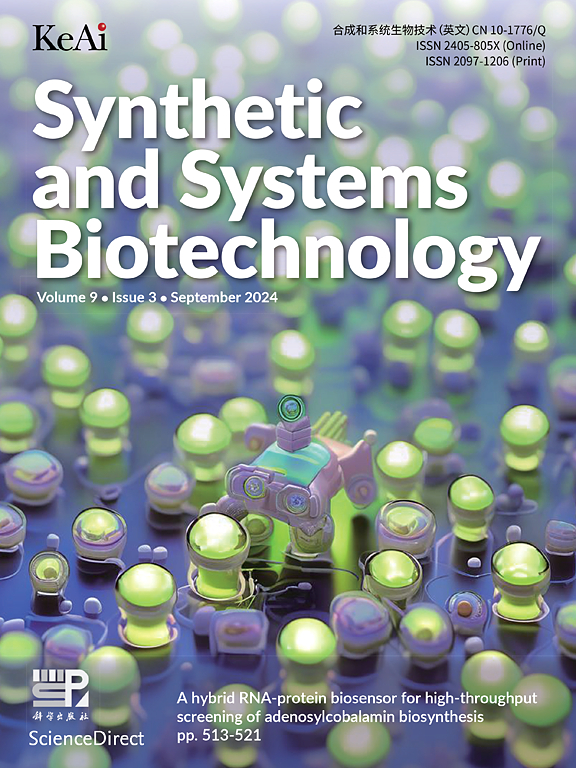Construction of a genome-engineered stable 5-aminolevulinic acid producing Corynebacterium glutamicum by increasing succinyl-CoA supply
IF 4.4
2区 生物学
Q1 BIOTECHNOLOGY & APPLIED MICROBIOLOGY
引用次数: 0
Abstract
5-Aminolevulinic acid (5-ALA), a versatile precursor for tetrapyrrole derivatives (such as heme, chlorophyll, and cobalamin), drives advancing microbial cell factories to meet growing biomedical and industrial demands. However, there remain two challenges that limit yield and scalability: the limitations of conventional plasmid-based gene expression systems and the lack of fine regulation of succinyl-CoA. In this study, to address these limitations, we integrated multiple copies of hemAC132A of the heterologous C4 pathway on the genome. For fine regulating the supply of succinyl-CoA, the genes related to the tricarboxylic acid cycle (TCA cycle) oxidation branch pathway were combinatorially screened. The optimal combination of icd and lpd was confirmed by ribosome binding site (RBS) engineering, which was integrated on the genome with optimized expression intensity. Succinyl-CoA supply was further increased by genome integration and expression optimization of key CoA biosynthetic gene coaA, pantothenic acid synthesis-related gene panB-panC, and β-alanine synthesis-related gene panD. The optimized genomically stable chassis achieved a high 5-ALA production of 6.38 ± 0.16 g/L, which was 8.63-fold higher than the single hemAC132A copy strain A1 (0.74 ± 0.07 g/L). From these findings, a stable and high-yield 5-ALA synthetic strain was successfully constructed, providing a new strategy for production of biochemicals derived from succinyl-CoA in C. glutamicum.
通过增加琥珀酰辅酶a供应构建基因组工程稳定的5-氨基乙酰丙酸产谷氨酸棒状杆菌
5-氨基乙酰丙酸(5-ALA)是四吡啶衍生物(如血红素、叶绿素和钴胺素)的多功能前体,推动着微生物细胞工厂的发展,以满足日益增长的生物医学和工业需求。然而,仍然存在两个限制产量和可扩展性的挑战:传统的基于质粒的基因表达系统的局限性和缺乏对琥珀酰辅酶a的精细调控。在本研究中,为了解决这些局限性,我们将异源C4途径的hemAC132A的多个拷贝整合到基因组上。为了精细调控琥珀酰辅酶a的供给,组合筛选了三羧酸循环(TCA循环)氧化分支通路相关基因。通过核糖体结合位点(RBS)工程确定icd与lpd的最佳组合,并以优化的表达强度整合到基因组上。通过对CoA生物合成关键基因coaA、泛酸合成相关基因panB-panC、β-丙氨酸合成相关基因panD的基因组整合和表达优化,进一步增加了琥珀酰辅酶a的供应。优化后的基因稳定基架的5-ALA产量为6.38±0.16 g/L,是hemAC132A单一拷贝菌株A1(0.74±0.07 g/L)的8.63倍。在此基础上,成功构建了一株稳定高产的5-ALA合成菌株,为谷氨酸琥珀酰辅酶a生化衍生物的生产提供了新的策略。
本文章由计算机程序翻译,如有差异,请以英文原文为准。
求助全文
约1分钟内获得全文
求助全文
来源期刊

Synthetic and Systems Biotechnology
BIOTECHNOLOGY & APPLIED MICROBIOLOGY-
CiteScore
6.90
自引率
12.50%
发文量
90
审稿时长
67 days
期刊介绍:
Synthetic and Systems Biotechnology aims to promote the communication of original research in synthetic and systems biology, with strong emphasis on applications towards biotechnology. This journal is a quarterly peer-reviewed journal led by Editor-in-Chief Lixin Zhang. The journal publishes high-quality research; focusing on integrative approaches to enable the understanding and design of biological systems, and research to develop the application of systems and synthetic biology to natural systems. This journal will publish Articles, Short notes, Methods, Mini Reviews, Commentary and Conference reviews.
 求助内容:
求助内容: 应助结果提醒方式:
应助结果提醒方式:


